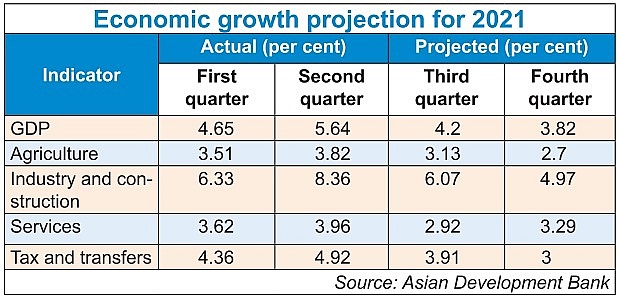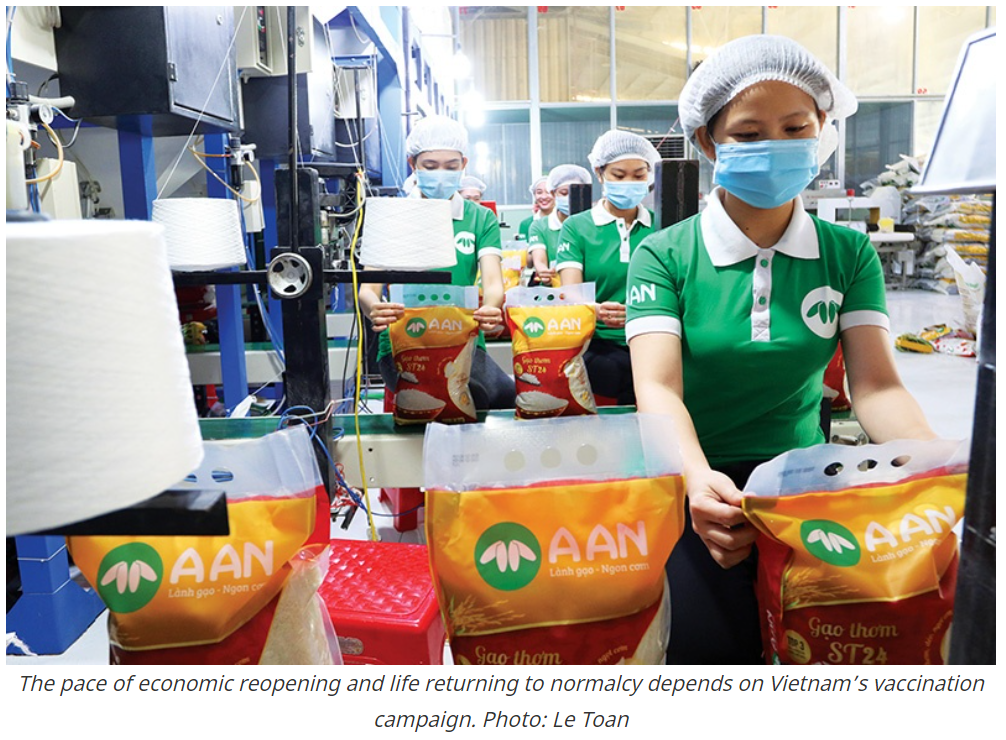Vietnam: Vaccine rollout critical for recovery
Vietnam’s economic growth this year is expected to slow down due to a resurgence of COVID-19 that has tightened the labour market, lowered industrial output, and disrupted agricultural value chains.
The slowdown in the economic recovery has earned Vietnam lower-than-expected growth forecasts from some high-profile international organisations – but one of the key solutions will be accelerating vaccinations in addition to materialising policies to help enterprises and individuals out of woes.
Last year Vietnam astounded the world by taming COVID-19, creating a growth rate of 2.92 per cent – listing it among a few nations with positive economic growth globally. The economy’s growth rates in the first and second quarters of 2021 were 4.48 and 6.61 per cent, respectively, and 5.64 per cent in the first half of the year.
However, since late June, parts of the country have been in strict lockdown and many factories, from those producing shoes for Nike to those churning out smartphones for Samsung, have either slowed or shut down, disrupting global supply chains.
After GDP growth accelerated in the second quarter, conditions appear less encouraging in Q3. Industrial output slumped at the fastest rate in over a year in August as the manufacturing sector fell deeper into contraction after July’s fall. Moreover, exports shrank at the sharpest pace since May 2020, in a further sign of struggling domestic production.
Thus, according to international organisations, this year could see even lower growth than the set target of 6.5 per cent by the government and about 6 per cent by the National Assembly.
 |
Lower projections with risks
Vietnam’s economic growth this year is expected to slow down due to a resurgence of COVID-19 that has tightened the labour market, lowered industrial output, and disrupted agricultural value chains.
The Asian Development Bank (ADB) last week released its Asian Development Outlook 2021 update, stating that Vietnam’s economy is expected to grow 3.8 per cent this year and 6.5 per cent in 2022.
“The prolonged pandemic and extended lockdowns have weakened consumption and investment, hampering Vietnam’s growth prospects,” said the ADB’s country director for Vietnam, Andrew Jeffries. “But the Vietnamese economy will bounce back if the pandemic is brought under control by the end of 2021 and 70 per cent of the country’s population are vaccinated by the second quarter of next year.”
In April, the ADB forecast in its update that Vietnam’s economic growth was expected to rebound to 6.7 per cent this year and 7 per cent in 2022.
Global analyst FocusEconomics has also just predicted that Vietnam’s GDP to “expand 5.3 per cent in 2021, which is down 0.5 percentage points from last month’s forecast, and 6.6 per cent in 2022, which is down 0.2 percentage points from last month”, according to a FocusEconomics report for October sent to VIR last week. In its September report released last month, FocusEconomics expected GDP to expand 5.8 per cent in 2021, which was down 0.6 percentage points from August’s forecast, and 6.8 per cent in 2022.
Minister of Planning and Investment Nguyen Chi Dung predicted that if COVID-19 is controlled in September, Vietnam’s GDP growth for 2021 may reach 3.5-4 per cent.
“If we want to reach this rate, greater efforts of the whole political system and localities must be made,” he said.
In Vietnam’s conditions, each percentage of growth represents around 400,000 new jobs.
The World Bank in August also released its latest prediction on Vietnam’s economic outlook, saying that Vietnam’s economy could expand by around 4.8 per cent in 2021 and 6.5 to 7 per cent from 2022 onward.
“This projection remains positive but it is 2 percentage points lower than the one in the December 2020 Taking Stock edition because of the negative effects associated with the latest outbreak and is subject to further risks to the downside,” said the bank’s August 2021 edition of the Taking Stock report, which analyses the grave aftermath of COVID-19 on the economy and its prospects.
This new projection assumes that the current outbreak will gradually be brought under control, allowing the economy to bounce back in the fourth quarter. This rebound will also be supported by the acceleration of the vaccination programme, which should cover at least 70 per cent of the adult population by mid-2022, preventing severe new outbreaks.
However, risks remain in the short- to medium-term outlook, according to the organisations. Specifically, the economic prospects will depend on several factors such as the pace of national vaccinations; the evolution of the pandemic and resumption of economic activities in countries that compete with Vietnam in export markets; and weaker-than-expected growth, especially in Vietnam’s key export markets could weigh on the recovery. Currently, the recovery in the US, the European Union, and China is underway but fragile.
“If one or more of these risks were to materialise, exports and domestic demand would not rebound as expected. The economy could, in a low-case scenario, still grow by 3.2 per cent in 2021 and 5.5 per cent in 2022,” the World Bank stated.
However, according to global economic analysts TradingEconomics, the annual GDP growth rate in Vietnam is expected to be 7.1 per cent by the end of this quarter.
“Looking forward, we estimate the GDP annual growth rate in Vietnam to stand at 6.3 per cent in 12 months’ time. In the long term, the rate is projected to trend around 6.5 per cent in 2022 and 5.9 per cent in 2023, according to our econometric models,” the group noted last week.
Remedies
Jeffries of the ADB said one of the most effective immediate solutions now to protect people’s lives and spur on economic activities is boosting vaccination and support for enterprises while removing administrative hurdles to business and people, and accelerating digital transformation. This will help improve the efficiency of pandemic containment measures and support a sustainable economic recovery this year and next.
While a rapid first-dose coronavirus vaccine rollout will help reduce infections and deaths, the low fully-vaccinated rate thus far in this country could prevent a full return to work in 2021, as only fully vaccinated people can go to work, Jeffries added. Excessive and paper-based procedures, especially in the issuance of travel certificates, have disrupted labour mobility and the food supply chain, exacerbating the impact of the pandemic on the economy.
“Enterprises are in critical need of much bigger support from the state,” Jeffries said. “Many of them have either halted performance or gone bankrupt.”
According to the ADB, cumbersome and unclear procedures constrain the disbursement of needed fiscal support for firms and people affected by COVID-19. As of late August, only about 32 per cent of a $1 billion social security support programme had been disbursed.
The National Assembly Standing Committee has adopted a resolution on solutions to assist enterprises and individuals hit by COVID-19, with four solutions.
There will be a cut of 30 per cent of corporate income tax in 2021 for businesses with total revenue in 2021 of not exceeding $8.7 million. This solution will cause a $95.65 million reduction in the state coffers.
There will also, moreover, be an exemption of personal income tax, VAT, and other types of taxes arising from business and production activities in the third and fourth quarters of 2021. This policy will deprive the state budget of $382.6 million in revenue. In addition is a reduction of VAT from October 1 to the end of the year for those operating in sectors such as transportation, hotels, catering, tourism, art and cinema, culture, and sports. This solution will earn the state $217.4 million in revenues.
What is more, there will also be an exemption of delayed payment of tax and land rent arising in 2020 and 2021 for those incurring losses in 2020. This policy will lead to a decrease of $230.43 million in the state budget.
Vietnam’s latest wave of the COVID-19 pandemic has been hitting enterprises and the labour market hard. In the first eight months of 2021, over 85,000 suspended operations, 24 per cent higher than in the same period last year. The lockdown and stringent movement restrictions disrupted labour mobility and hampered production.
Source: VIR


 English
English




